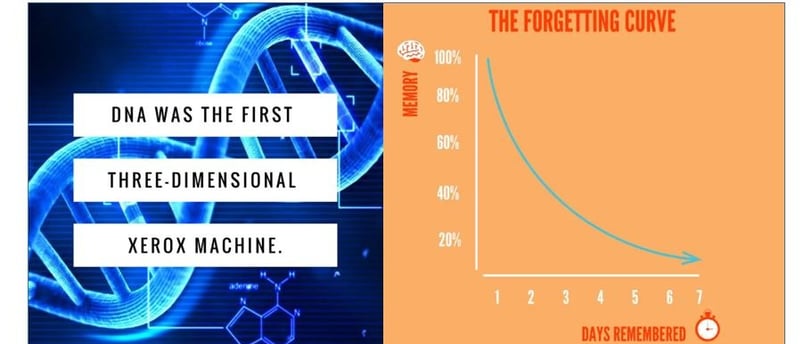CREATIVE LEARNING EXPERIENCES THAT CHANGE BEHAVIOR
DNA is your personal 3-D Xerox Machine of Memory
We forget almost everything. But when we don’t, where is it stored?
LEARNER RETENTION
Lesley S
6/3/20252 min read


We forget pretty much everything - especially if it’s important, including:
Keys, wallet & even your second brain: your phone.
Why you went into this room.
Where you parked.
People's names.
Annual milestone dates like birthdays & anniversaries.
The milk…especially when it’s the reason you even went to the store.
Watering the plants.
Feeding the fish.
That VERY amazing thing you were about to say.
I'm sure I forgot something important.
We’ve been forgetting important stuff for a while now. In 1885, German psychologist Hermann Ebbinghaus wrote an entire weighty book about it in which he described the shape of what we now call the Forgetting Curve.
The Forgetting Curve shows that when you learn something new, unless you revisit it repeatedly, it will take less than a week for you to have forgotten it. But not everything is relegated to Fuhgidabouditville. This persistent 30% that are “memory traces” puzzle researchers as well.
In particular, where they are stored.
Is it within the synapses of neurons? They do undergo structural changes when a memory forms, but structural changes at the synapse of neurons have limited storage capacity for the total amount of memories they can accommodate. So what is more likely is that when a new memory becomes encoded, within a week or so, it changes the structure of DNA. Structural changes in DNA not only mean the memory can become permanent – but there’s no capacity limit.
“The DNA hypothesis is attractive because it offers a solution to the problem of capacity…structural changes in DNA would allow for an almost limitless number of memories to be permanently stored.” The Form of the Forgetting Curve and the Fate of Memories, Journal of Mathematical Psychology (2011)
image source
To deploy your internal Xerox machine on the stuff you want to remember, MaxLearn advises this two-part strategy:
Review, review, review. Repetitively. If you want to remember it, review it. Repetition keeps it from being forgotten. And repetition at longer and longer intervals - spaced repetition - cements it into long-term memory.
Don’t binge – snack. Committing a lot of stuff to long term memory is like eating an entire elephant: it’s not possible to choke everything down all at once. Snacks are the secret (aka micro-learning). The optimal snack size seems to be about 7 minutes.

